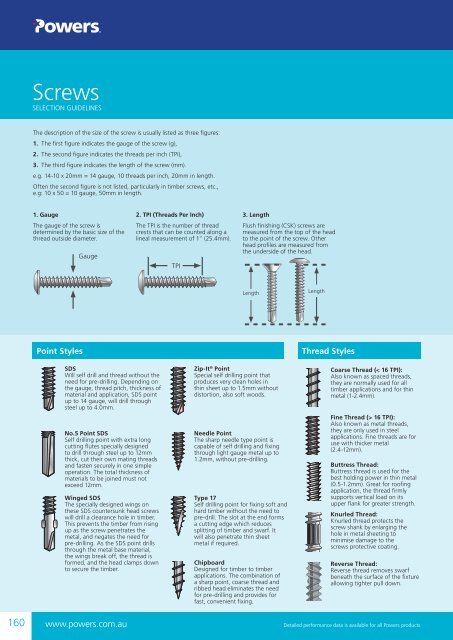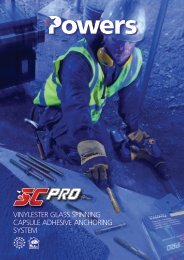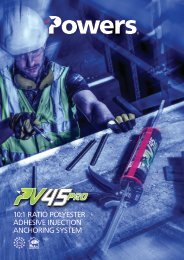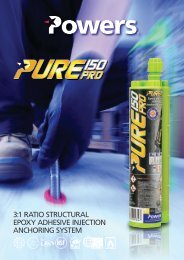Powers Buyers Guide
You also want an ePaper? Increase the reach of your titles
YUMPU automatically turns print PDFs into web optimized ePapers that Google loves.
Screws<br />
SELECTION GUIDELINES<br />
The description of the size of the screw is usually listed as three figures:<br />
1. The first figure indicates the gauge of the screw (g),<br />
2. The second figure indicates the threads per inch (TPI),<br />
3. The third figure indicates the length of the screw (mm).<br />
e.g. 14-10 x 20mm = 14 gauge, 10 threads per inch, 20mm in length.<br />
Often the second figure is not listed, particularly in timber screws, etc.,<br />
e.g: 10 x 50 = 10 gauge, 50mm in length.<br />
1. Gauge<br />
The gauge of the screw is<br />
determined by the basic size of the<br />
thread outside diameter.<br />
Gauge<br />
2. TPI (Threads Per Inch)<br />
The TPI is the number of thread<br />
crests that can be counted along a<br />
lineal measurement of 1” (25.4mm).<br />
TPI<br />
3. Length<br />
Flush finishing (CSK) screws are<br />
measured from the top of the head<br />
to the point of the screw. Other<br />
head profiles are measured from<br />
the underside of the head.<br />
Length<br />
Length<br />
Point Styles<br />
SDS<br />
Will self drill and thread without the<br />
need for pre-drilling. Depending on<br />
the gauge, thread pitch, thickness of<br />
material and application, SDS point<br />
up to 14 gauge, will drill through<br />
steel up to 4.0mm.<br />
No.5 Point SDS<br />
Self drilling point with extra long<br />
cutting flutes specially designed<br />
to drill through steel up to 12mm<br />
thick, cut their own mating threads<br />
and fasten securely in one simple<br />
operation. The total thickness of<br />
materials to be joined must not<br />
exceed 12mm.<br />
Winged SDS<br />
The specially designed wings on<br />
these SDS countersunk head screws<br />
will drill a clearance hole in timber.<br />
This prevents the timber from rising<br />
up as the screw penetrates the<br />
metal, and negates the need for<br />
pre-drilling. As the SDS point drills<br />
through the metal base material,<br />
the wings break off, the thread is<br />
formed, and the head clamps down<br />
to secure the timber.<br />
Zip-It ® Point<br />
Special self drilling point that<br />
produces very clean holes in<br />
thin sheet up to 1.5mm without<br />
distortion, also soft woods.<br />
Needle Point<br />
The sharp needle type point is<br />
capable of self drilling and fixing<br />
through light gauge metal up to<br />
1.2mm, without pre-drilling.<br />
Type 17<br />
Self drilling point for fixing soft and<br />
hard timber without the need to<br />
pre-drill. The slot at the end forms<br />
a cutting edge which reduces<br />
splitting of timber and swarf. It<br />
will also penetrate thin sheet<br />
metal if required.<br />
Chipboard<br />
Designed for timber to timber<br />
applications. The combination of<br />
a sharp point, coarse thread and<br />
ribbed head eliminates the need<br />
for pre-drilling and provides for<br />
fast, convenient fixing.<br />
Thread Styles<br />
Coarse Thread (< 16 TPI):<br />
Also known as spaced threads,<br />
they are normally used for all<br />
timber applications and for thin<br />
metal (1-2.4mm).<br />
Fine Thread (> 16 TPI):<br />
Also known as metal threads,<br />
they are only used in steel<br />
applications. Fine threads are for<br />
use with thicker metal<br />
(2.4-12mm).<br />
Buttress Thread:<br />
Buttress thread is used for the<br />
best holding power in thin metal<br />
(0.5-1.2mm). Great for roofing<br />
application, the thread firmly<br />
supports vertical load on its<br />
upper flank for greater strength.<br />
Knurled Thread:<br />
Knurled thread protects the<br />
screw shank by enlarging the<br />
hole in metal sheeting to<br />
minimise damage to the<br />
screws protective coating.<br />
Reverse Thread:<br />
Reverse thread removes swarf<br />
beneath the surface of the fixture<br />
allowing tighter pull down.<br />
160 www.powers.com.au Detailed performance data is available for all <strong>Powers</strong> products







